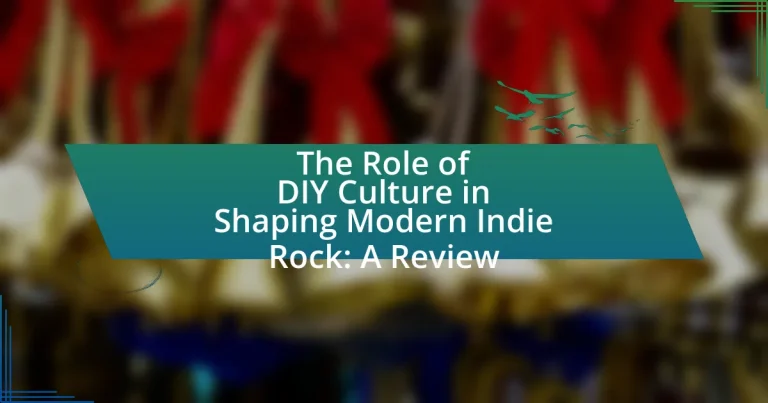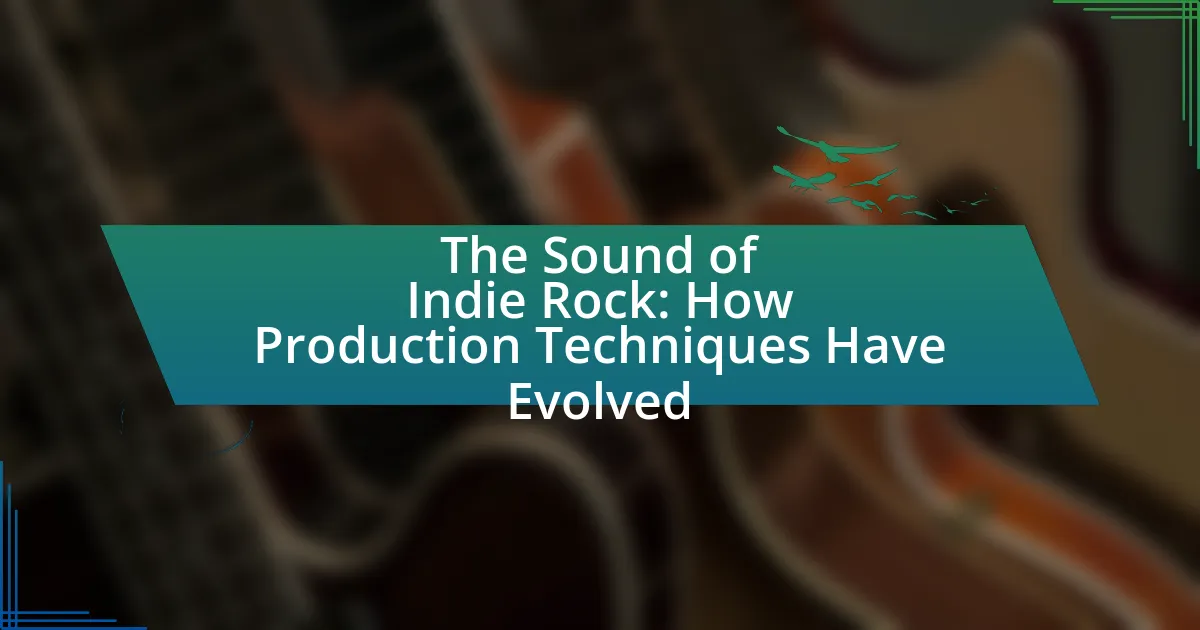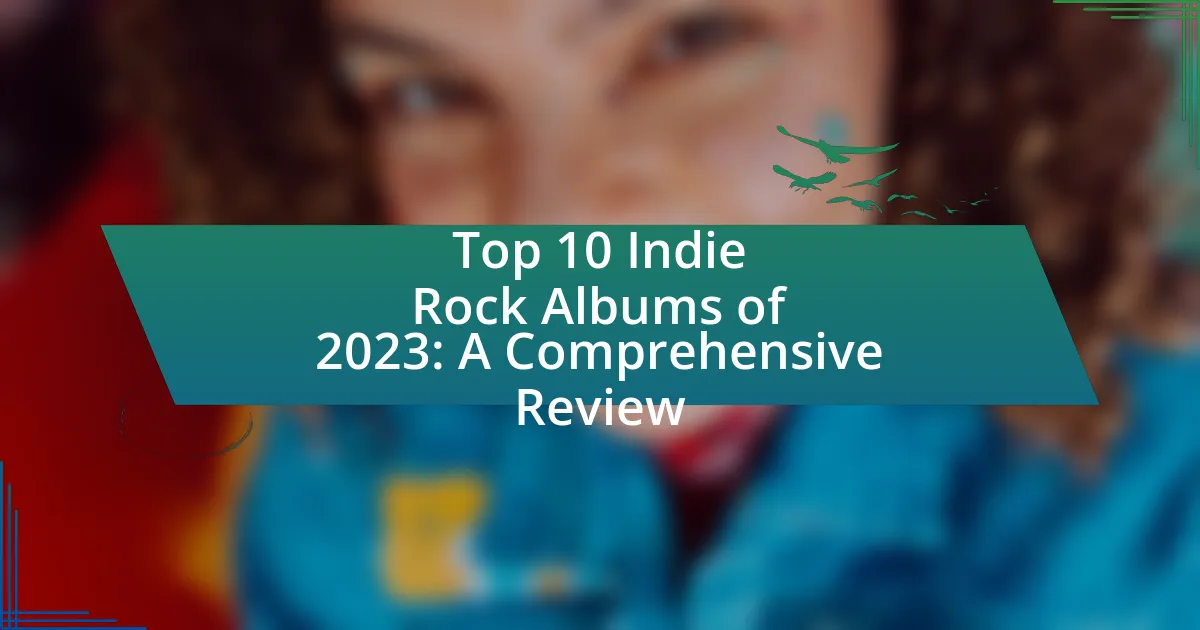The article examines the significant role of DIY culture in shaping modern indie rock, highlighting how it empowers artists to create, produce, and distribute their music independently. It traces the emergence of DIY culture as a response to the commercialization of music, influenced by the punk rock movement and advancements in recording technology. Key topics include the impact of digital platforms on music distribution, the challenges faced by DIY musicians, and the importance of community engagement in fostering collaboration and creativity within the indie rock scene. The article also discusses best practices for aspiring artists and the resources available to enhance their skills in this evolving landscape.

What is the role of DIY culture in modern indie rock?
DIY culture plays a crucial role in modern indie rock by empowering artists to create, produce, and distribute their music independently. This autonomy allows musicians to maintain creative control and authenticity, which are central tenets of the indie rock ethos. The rise of digital technology and social media has further facilitated this movement, enabling artists to reach audiences directly without the need for major label support. For instance, platforms like Bandcamp and SoundCloud have become essential tools for indie musicians, allowing them to share their work and connect with fans globally. This shift has led to a diverse range of sounds and styles within the genre, reflecting the varied influences and backgrounds of the artists involved.
How did DIY culture emerge within the indie rock scene?
DIY culture emerged within the indie rock scene as a response to the commercialization of music in the late 20th century. This movement was characterized by musicians and fans prioritizing self-production, independent labels, and grassroots promotion over traditional music industry pathways. The rise of affordable recording technology in the 1980s and 1990s enabled artists to create and distribute their music without major label support, exemplified by bands like Sonic Youth and their involvement with independent labels such as SST Records. Additionally, the punk rock ethos of the 1970s laid the groundwork for DIY principles, emphasizing authenticity and community engagement, which resonated with indie rock artists seeking creative freedom. The proliferation of zines, house shows, and independent record stores further solidified this culture, fostering a sense of belonging and collaboration among musicians and fans alike.
What historical events contributed to the rise of DIY culture in music?
The rise of DIY culture in music was significantly influenced by the punk rock movement of the 1970s, which emphasized self-production and independent distribution. This movement arose as a reaction against the mainstream music industry, leading bands like the Ramones and Sex Pistols to create music outside traditional record label systems. Additionally, the advent of affordable recording technology in the 1980s, such as four-track recorders, allowed musicians to produce their own music at home, further democratizing music creation. The establishment of independent record labels, like SST Records and Dischord Records, provided platforms for these DIY artists, reinforcing the culture. The 1990s saw the rise of the internet, which facilitated the sharing and distribution of music without the need for major labels, solidifying the DIY ethos in the music scene.
How did technological advancements influence DIY practices in indie rock?
Technological advancements significantly influenced DIY practices in indie rock by providing accessible tools for music production, distribution, and promotion. The advent of affordable recording software and hardware, such as digital audio workstations (DAWs) and home recording equipment, enabled independent artists to produce high-quality music without the need for expensive studio time. Additionally, the rise of the internet and platforms like Bandcamp and SoundCloud allowed musicians to distribute their work directly to audiences, bypassing traditional record labels. This shift democratized the music industry, as evidenced by the increase in self-released albums; for instance, in 2019, over 40% of music released was independent, highlighting the impact of technology on the DIY ethos in indie rock.
Why is DIY culture significant for indie rock artists?
DIY culture is significant for indie rock artists because it empowers them to create, produce, and distribute their music independently, bypassing traditional industry gatekeepers. This autonomy allows artists to maintain creative control over their work, fostering authenticity and innovation. Historically, the rise of DIY culture in the 1980s and 1990s, exemplified by bands like Sonic Youth and Fugazi, demonstrated that artists could achieve commercial success and critical acclaim without major label support. Additionally, the accessibility of technology and social media has further enabled indie rock artists to reach audiences directly, enhancing their visibility and engagement.
What advantages does DIY culture provide to emerging musicians?
DIY culture provides emerging musicians with greater creative control, cost-effective production, and direct access to audiences. By embracing DIY methods, musicians can produce and distribute their music without the constraints of traditional record labels, allowing for artistic freedom and innovation. This approach also reduces financial barriers, as artists can utilize affordable recording technology and platforms for self-promotion, such as social media and streaming services. Furthermore, DIY culture fosters community engagement, enabling musicians to connect directly with fans through live performances and grassroots marketing, which can lead to a loyal following and increased visibility in the competitive music landscape.
How does DIY culture foster creativity and artistic freedom?
DIY culture fosters creativity and artistic freedom by empowering individuals to create and distribute their work independently, bypassing traditional gatekeepers in the music industry. This autonomy allows artists to explore unconventional ideas and styles without commercial constraints, leading to innovative sounds and diverse expressions. For instance, the rise of home recording technology and online platforms has enabled musicians to produce and share their music directly with audiences, exemplified by the success of indie artists like Sufjan Stevens and Bon Iver, who gained recognition through self-released projects. This democratization of music production not only encourages experimentation but also cultivates a community where collaboration and support thrive, further enhancing artistic expression.
What challenges do artists face within the DIY framework?
Artists face several challenges within the DIY framework, including limited access to resources, financial constraints, and difficulties in marketing and distribution. Limited access to professional recording studios and high-quality equipment can hinder the production of polished music, while financial constraints often prevent artists from investing in promotional activities or touring. Additionally, the lack of established distribution channels makes it challenging for DIY artists to reach wider audiences, as they must rely on social media and grassroots efforts to promote their work. These challenges are compounded by the competitive nature of the music industry, where many artists struggle to gain visibility amidst a vast number of independent releases.
How do financial constraints impact DIY musicians?
Financial constraints significantly limit DIY musicians’ ability to produce, promote, and distribute their music. These limitations often result in reduced access to professional recording studios, high-quality equipment, and marketing resources, which are essential for creating competitive music. For instance, a study by the Music Industry Research Association found that 70% of independent musicians reported financial barriers as a major obstacle to their career advancement. Consequently, many DIY musicians resort to low-budget recording methods and rely heavily on social media for promotion, which can hinder their visibility and growth in a saturated market.
What are the common pitfalls of the DIY approach in indie rock?
The common pitfalls of the DIY approach in indie rock include limited resources, lack of professional expertise, and difficulties in marketing and distribution. Limited resources often result in subpar production quality, which can hinder the overall sound and appeal of the music. Additionally, many indie artists lack the professional expertise needed for effective promotion, leading to missed opportunities for audience engagement. Furthermore, the challenges in marketing and distribution can prevent artists from reaching wider audiences, as they may struggle to navigate the complexities of digital platforms and social media. These factors collectively contribute to the difficulties faced by indie rock musicians who adopt a DIY approach.
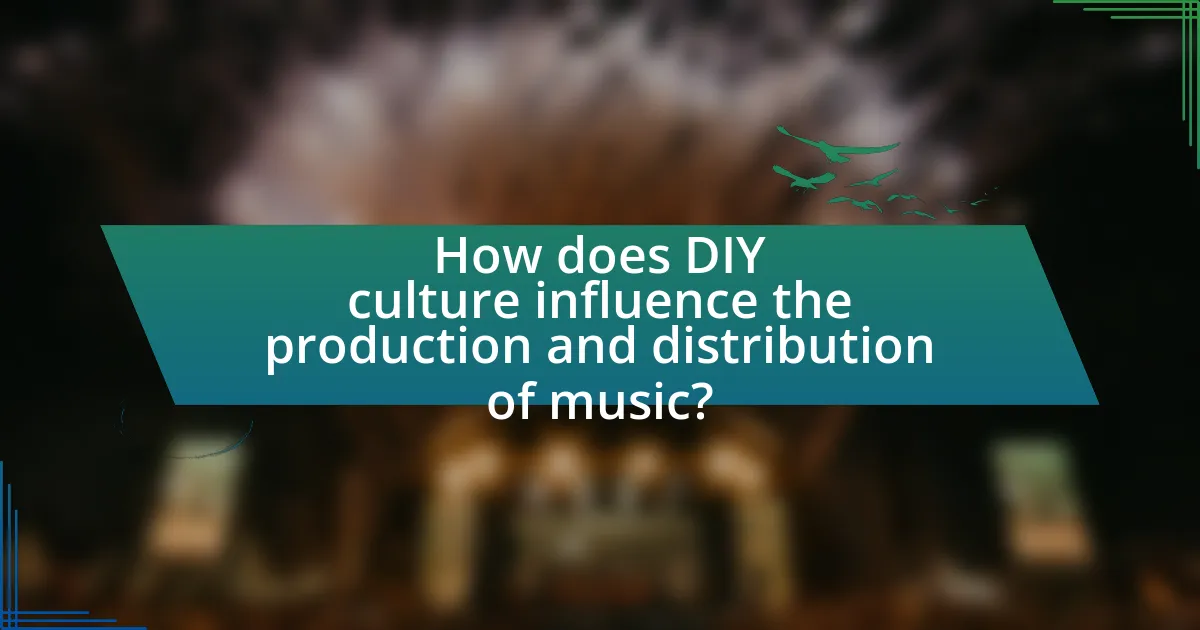
How does DIY culture influence the production and distribution of music?
DIY culture significantly influences the production and distribution of music by empowering artists to create and share their work independently, bypassing traditional industry gatekeepers. This cultural movement has led to the rise of home recording technologies and affordable distribution platforms, enabling musicians to produce high-quality recordings without the need for major label support. For instance, the advent of digital audio workstations and platforms like Bandcamp and SoundCloud has democratized music distribution, allowing artists to reach global audiences directly. According to a 2020 study by the International Federation of the Phonographic Industry, independent artists accounted for 40% of global music revenues, highlighting the substantial impact of DIY practices on the music industry.
What are the key methods of music production in the DIY scene?
The key methods of music production in the DIY scene include home recording, the use of affordable software, and collaboration among artists. Home recording allows musicians to produce high-quality tracks using basic equipment, such as microphones and audio interfaces, which has become increasingly accessible due to advancements in technology. Affordable software, like digital audio workstations (DAWs), enables artists to edit and mix their music without the need for expensive studio time. Collaboration among artists fosters creativity and resource sharing, often leading to innovative sounds and techniques. These methods have been validated by the rise of independent labels and self-released music, which have significantly contributed to the modern indie rock landscape.
How do home studios change the landscape of music recording?
Home studios significantly change the landscape of music recording by democratizing access to high-quality production tools. This shift allows independent artists to create, produce, and distribute music without the need for expensive studio time or major label backing. According to a 2020 report by the International Federation of the Phonographic Industry, the rise of home studios has contributed to a 30% increase in self-released music, showcasing the growing trend of DIY culture in the music industry. This accessibility empowers musicians to experiment creatively and maintain control over their artistic vision, fundamentally altering traditional recording practices.
What role do independent labels play in supporting DIY artists?
Independent labels play a crucial role in supporting DIY artists by providing resources, distribution, and marketing that enable these artists to reach wider audiences. These labels often offer financial backing, production facilities, and industry connections that are typically inaccessible to independent musicians. For instance, according to a study by the Music Industry Research Association, independent labels accounted for over 30% of global music sales in 2020, demonstrating their significant impact on the music market. Additionally, independent labels often prioritize artistic freedom, allowing DIY artists to maintain creative control over their work, which is essential for their artistic identity and growth.
How do DIY artists distribute their music without major labels?
DIY artists distribute their music without major labels primarily through digital platforms and social media. They utilize services like Bandcamp, SoundCloud, and Spotify to upload and share their music directly with listeners, bypassing traditional distribution channels. Additionally, they leverage social media platforms such as Instagram, Facebook, and TikTok to promote their work and engage with fans, creating a direct connection that enhances their visibility. According to a 2021 report by the International Federation of the Phonographic Industry, independent artists accounted for 40% of global music consumption, highlighting the effectiveness of these distribution methods in reaching audiences without the backing of major labels.
What platforms are most effective for DIY music distribution?
The most effective platforms for DIY music distribution include Bandcamp, DistroKid, and TuneCore. Bandcamp allows artists to sell music directly to fans, offering a fair revenue share and tools for merchandise sales. DistroKid and TuneCore provide comprehensive distribution services to major streaming platforms like Spotify and Apple Music, enabling artists to reach a wider audience. According to a 2021 report by the International Federation of the Phonographic Industry, independent artists using these platforms have seen significant growth in their revenue streams, highlighting their effectiveness in the DIY music distribution landscape.
How does social media impact the reach of DIY musicians?
Social media significantly enhances the reach of DIY musicians by providing them with platforms to share their music directly with audiences worldwide. This direct access allows musicians to bypass traditional gatekeepers, such as record labels and radio stations, which historically limited exposure. For instance, a study by the Pew Research Center in 2021 found that 72% of adults in the U.S. use social media, creating a vast potential audience for independent artists. Additionally, platforms like Instagram, TikTok, and YouTube enable musicians to engage with fans, promote their work, and build communities, further amplifying their visibility and reach.
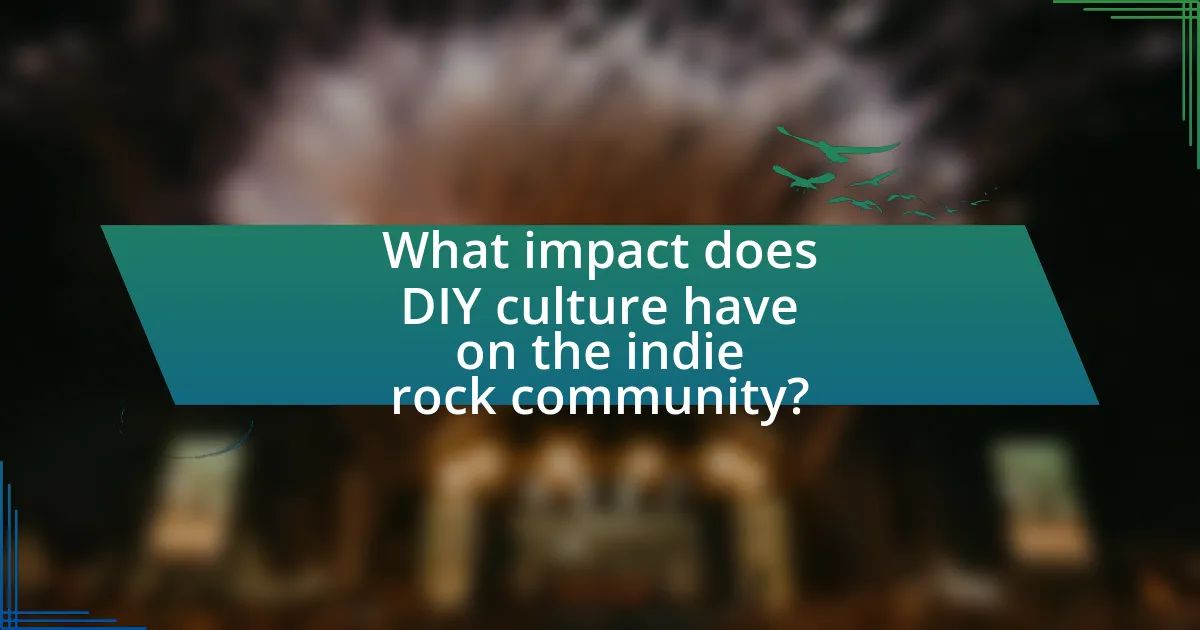
What impact does DIY culture have on the indie rock community?
DIY culture significantly empowers the indie rock community by promoting artistic freedom and self-sufficiency. This cultural movement encourages musicians to produce, distribute, and promote their music independently, bypassing traditional industry gatekeepers. For instance, many successful indie bands, such as Death Cab for Cutie and The Decemberists, began their careers by self-releasing albums and organizing their own tours, which allowed them to cultivate dedicated fan bases without major label support. Additionally, DIY culture fosters a sense of community and collaboration among artists, as seen in the rise of collective spaces like DIY venues and record labels, which provide resources and support for emerging musicians. This grassroots approach not only democratizes music production but also enhances the diversity and authenticity of the indie rock genre.
How does DIY culture promote collaboration among artists?
DIY culture promotes collaboration among artists by fostering an environment where resources, skills, and ideas are shared freely. This culture encourages artists to work together on projects, often leading to the creation of collective works that blend diverse styles and perspectives. For instance, many indie rock musicians participate in local music scenes that prioritize collaboration over competition, resulting in joint performances, co-writing sessions, and shared recording spaces. Research indicates that such collaborative efforts can enhance creativity and innovation, as artists draw inspiration from one another’s unique approaches and experiences.
What are the benefits of community-driven projects in indie rock?
Community-driven projects in indie rock foster collaboration, enhance creativity, and build strong local networks. These projects allow artists to share resources, such as recording spaces and promotional platforms, which can lead to higher quality music production and wider audience reach. For instance, initiatives like local music festivals or cooperative record labels enable musicians to connect with fans and other artists, creating a supportive ecosystem. Research indicates that community engagement in music can increase attendance at live events by up to 30%, demonstrating the tangible impact of these collaborative efforts on the indie rock scene.
How do local scenes thrive through DIY initiatives?
Local scenes thrive through DIY initiatives by fostering community engagement and providing accessible platforms for artists. These initiatives enable musicians to create, promote, and distribute their work independently, circumventing traditional industry barriers. For instance, venues that host local shows, community workshops, and collaborative projects encourage networking and skill-sharing among artists, which strengthens the local music ecosystem. Research indicates that DIY spaces contribute to a sense of belonging and identity within communities, as seen in the rise of grassroots movements in cities like Portland and Austin, where local artists have successfully built vibrant music scenes through collective efforts.
What role does DIY culture play in shaping audience engagement?
DIY culture significantly enhances audience engagement by fostering a sense of community and ownership among fans. This culture encourages individuals to participate actively in the creation and distribution of music, leading to deeper connections with artists and their work. For instance, the rise of platforms like Bandcamp and social media allows fans to directly support indie artists, share their music, and even collaborate on projects, which strengthens their investment in the music. Research indicates that audiences who engage with DIY initiatives are more likely to attend live shows and promote artists within their networks, further amplifying the reach and impact of the music.
How do DIY shows and events foster a sense of community?
DIY shows and events foster a sense of community by creating inclusive spaces where individuals can connect through shared interests in music and creativity. These gatherings often encourage collaboration among local artists, allowing them to showcase their talents and engage with audiences in a personal setting. Research indicates that participation in DIY events enhances social bonds, as attendees often form friendships and networks based on mutual appreciation for the art and culture presented. Furthermore, the grassroots nature of DIY culture promotes accessibility, enabling diverse groups to participate, which strengthens community ties and fosters a collective identity among attendees.
What are the implications of audience participation in DIY culture?
Audience participation in DIY culture significantly enhances community engagement and fosters creativity among individuals. This active involvement allows fans to contribute to the artistic process, leading to a more collaborative environment where diverse voices are heard. For instance, studies show that in DIY music scenes, such as those in indie rock, audience members often take on roles beyond mere listeners, participating in events, creating content, and even influencing the direction of projects. This participatory approach not only democratizes the music-making process but also strengthens the bond between artists and their audiences, as seen in the rise of platforms like Bandcamp, where fans can directly support and interact with musicians.
What are some best practices for aspiring DIY indie rock artists?
Aspiring DIY indie rock artists should focus on building a strong online presence, creating quality recordings, and engaging with their local music community. Establishing an online presence through social media platforms and music streaming services allows artists to reach a wider audience and showcase their work effectively. Quality recordings are essential; artists should invest in good equipment or seek affordable recording studios to ensure their music sounds professional. Engaging with the local music community through live performances, collaborations, and networking can lead to valuable opportunities and support. These practices are supported by the success of numerous indie artists who have leveraged online platforms and community engagement to grow their fan base and achieve recognition in the music industry.
How can artists effectively promote their DIY music projects?
Artists can effectively promote their DIY music projects by leveraging social media platforms, engaging with local communities, and utilizing digital distribution services. Social media allows artists to reach a broad audience, with platforms like Instagram and TikTok enabling direct interaction with fans and the sharing of music content. Engaging with local communities through live performances, open mic nights, and collaborations with other local artists fosters a supportive network and increases visibility. Additionally, using digital distribution services like Bandcamp and SoundCloud helps artists to distribute their music widely while retaining control over their work. According to a 2021 survey by the Music Industry Research Association, 70% of independent artists reported that social media was their most effective promotional tool, highlighting its significance in the DIY music landscape.
What resources are available for DIY musicians to enhance their skills?
DIY musicians can enhance their skills through various resources, including online courses, workshops, and community forums. Platforms like Coursera and Skillshare offer courses on music production, songwriting, and marketing tailored for independent artists. Additionally, local music schools and community centers often host workshops that provide hands-on experience and networking opportunities. Online forums such as Reddit’s r/WeAreTheMusicMakers allow musicians to share knowledge, seek advice, and collaborate with peers, fostering a supportive community. These resources collectively empower DIY musicians to develop their craft and navigate the music industry effectively.
